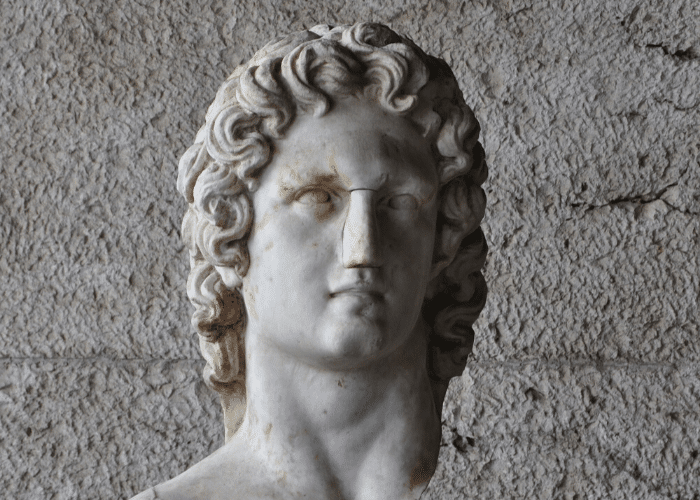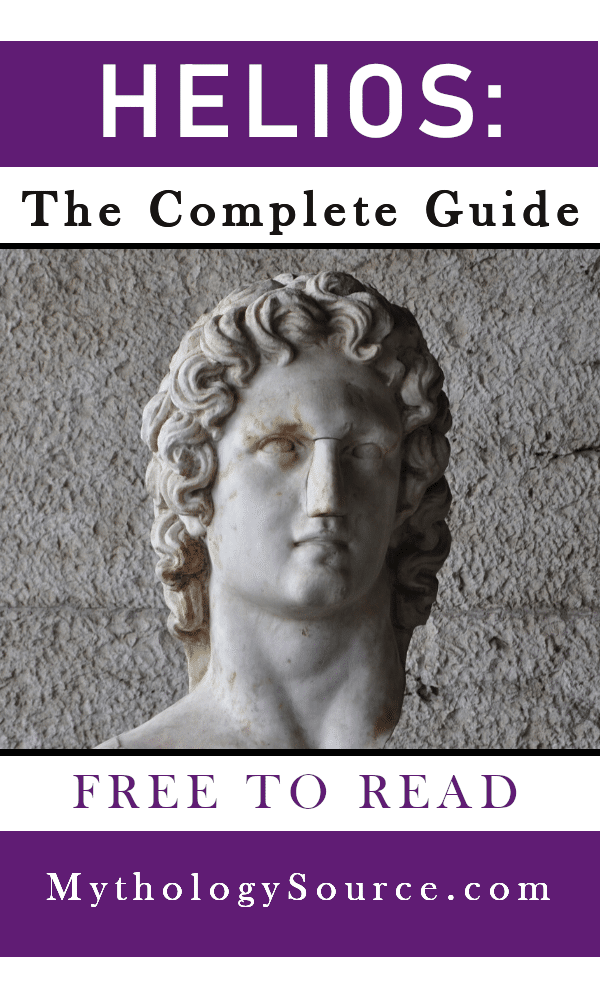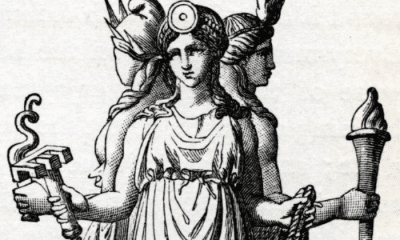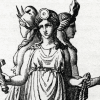
Greek
Helios: The God of the Sun
Helios: The God of the Sun
He drove his chariot across the sky every day, bringing the light of the sun to the world he watched over. If you’re thinking of Apollo, think again! We’re talking about Helios, the god of the sun.
Helios was one of the most hard-working gods of the Greek pantheon.
Every day he drove a chariot pulled by four spirited horses across the sky. He worked, quite literally, from sunrise to sunset.
That’s because Helios was the Greek god of the sun. The golden chariot he drove moved his light across the sky through the hours of the day.
His job was so difficult and dangerous that he had to use a special salve to keep the heat of the sun from burning him beyond recognition.
Helios is often conflated with Apollo, who was also a god of light. But unlike that busy god, Helios was too busy lighting the sky all day long to take on many other roles.
From his position in the sky, the god of the sun could see everything that happened below. His many children sometimes helped him with his work, but at other times caused tragic accidents.
Keep reading to learn all about Helios, the Greek god of the sun!
The Family of Helios
Helios was not one of the gods of Olympus, although he worked alongside of them.
He was the son of the Titan god of light, Hyperion, and his wife Thea. Thea was also a goddess of light and of the blue sky, so it is unsurprising that their children were associated with both bright light and the heavens.
He was often called Helios Hyperion, after his father. While some interpretations raise the possibility that the two were the same being, there are sources that specifically refer to him as the son of that Titan.
Helios was the second of three children born to Hyperion and Thea.
The first, Eos, was the goddess of the dawn. She never moved across the sky, but just lit the Eastern horizon with a warm glow before Helios appeared each morning.
His younger sister was Selene, the goddess of the moon. Like Helios she pulled a chariot across the sky, but her light was dimmer and cooler.
Although they belonged to the second generation of Titans, the children of Hyperion were not imprisoned after Zeus won the throne from Chronos. They sided with the new gods, and in doing so secured places in the pantheon of the Olympians.
Helios, in fact, was described by many authors as taking part in the wars that Zeus fought to secure his throne. In the battle against the Gigantes he saved Hephaestus from the battlefield when the smith grew too exhausted to continue fighting.
Helios was worshipped not only as the physical sun but as the power of creation and life it contained. In illuminating the world, he was praised as a god of creation.
The Home of the Sun-Crowned God
Helios was usually depicted as a handsome young man. One of his most defining attributes was the radiating crown of the sun’s rays that surrounded his head.
He was said to have bright, piercing eyes and golden hair.
The most famous image of the sun god in the ancient world was also one of its great wonders.
The Colossus of Rhodes was built on the island that was one of the god’s main cult centers. Standing over 100 feet high, the enormous statue depicted Helios crowned by the sun and looking out over the harbor.
Unfortunately, the Colossus of Rhodes only stood for a little over fifty years. It was destroyed by an earthquake in 226 BC and never rebuilt.
Outside of sculpture, Helios was almost always shown on his chariot, which some myths claimed he had invented. Drawn by four immortal horses, he drove this vehicle across the dome of the sky every day.
This iconography was not unique to Greece. The charioteer sun god seems to have originated in the Near East.
The figure of Helios is connected through iconography and purpose to the god Mithras. Originally an angelic being of the Persians, Mithratic cults became popular in Rome where he was worshipped as a deity of the sun and creation.
Helios moved across the sky by day, but unlike many of the gods he did not return to Olympus by night. His light would have been too bright for the other gods to endure while the slept, so the palace of Helios was a more private place.
The great river Oceanus encircled the earth, and each night Helios went past its western horizon. There, he had his home.
Ovid described the palace of Helios as one of the most wondrous buildings in existence. It was made of gold, bronze, and ivory so that it reflected such dazzling light that none but the immortal gods could bear to look at it.
His throne was even brighter. There, he was attended by the Horai (Seasons) and the personifications of all the divisions of time.
Helios never had much time to rest, however. Before morning, he left his Western home and travelled beneath Oceanus and Gaia to reach the Eastern edge of the world again by the time his sister Eos announced his arrival.
Helios Panoptes
Crossing the sky each day and illuminating the world below him, Helios had the perfect vantage point for seeing everything that happened in the world by day.
He was given the epithet Panoptes, or all-seeing. Only deeds done by night or in the deepest shadows could be hidden from his knowledge.
The all-seeing eyes of Helios factored often in the ancient myths. When the other gods, who despite their many powers were not omniscient, needed information they asked the sun god for his help.
One of the most notable examples of the aid Helios was able to provide was in the disappearance of Persephone.
The daughter of Demeter, Persephone had been abducted to the underworld by Hades, who intended to make her his wife. Demeter had no knowledge of this plan, even though her brother Zeus had arranged it.
On a day that Persephone and her attendants were picking flowers in a meadow, away from her mother’s protection, Hades burst up from the underworld on his chariot and kidnapped the maiden goddess. She had time to give only one cry before she was pulled into the underworld.
When Demeter realized her daughter was missing she began a frantic search. For nine days she wandered the earth, wildly searching for any sign of Persephone.
On the tenth day she came across Hecate, who had heard the girl’s scream. The goddess of witchcraft, however, did not know who had taken the missing goddess.
She suggested that Demeter consult Helios who, from his position high above the earth, would have almost certainly seen the abduction take place.
Helios, do you at least regard me, goddess as I am, if ever by word or deed of mine I have cheered your heart and spirit. Through the fruitless air I heard the thrilling cry of my daughter whom I bare, sweet scion of my body and lovely in form, as of one seized violently; though with my eyes I saw nothing. But you–for with your beams you look down from the bright upper air over all the earth and sea–tell me truly of my dear child if you have seen her anywhere, what god or mortal man has violently seized her against her will and mine, and so made off.
-Homeric Hymn 2 to Demeter 19 ff (trans. Evelyn-White)
Helios was finally able to give Demeter the answers she had been looking for. Not only had he seen Persephone’s abduction by Hades, but he also knew that Hades and Zeus had worked together to plan it.
Armed with this knowledge, Demeter was able to leverage her power over crops to force Persephone’s return. While the younger goddess still had to spend part of the year in the realm of Hades, she was able to return to spend most of her time with her mother.
While Demeter had to seek out Helios to learn what he had seen, at other times the god offered the information more freely.
The smith god Hephaestus, who had been born lame, had won the right to marry Aphrodite.
The goddess of beauty, however, was unhappy with the match. She had hoped to marry her long-time paramour Ares instead.
The two continued their affair behind her husband’s back, thinking that they were careful to keep the secret to themselves.
They had forgotten, however, about the watchful eyes of Helios far above them. The sun god reported what he had seen to Hephaestus.
Without the information given by Helios, Hephaestus might never have learned about his wife’s infidelity. He set a trap to catch Aphrodite and Ares in the act, humiliating them in front of the other gods.
The episode led to the separation of Hephaestus and Aphrodite, who both remarried into happier partnerships.
The Children of the Sun
Helios himself did not marry, although he had many consorts. His children were numerous as well.
Probably the most well-known story of one of the children of Helios is that of Phaethon.
The son of one of the nereids, Phaethon was characterized as an impetuous and headstrong young man.
Phaethon often accompanied his father and continuously begged to be allowed to steer the chariot as it flew across the sky. Helios was reluctant, but eventually gave in and let his son take the chariot while he took a day of rest.
This proved to be a terrible mistake. The young man quickly lost control of the immortal horses and the chariot’s path began to swing wildly.
It dove too close to the ground, scorching the earth as it got close. The heat of the sun blazed a path across North Africa, leaving a barren landscape of charred earth and dry sand behind it.
Zeus was horrified at the destruction Phaeton was causing. He feared that the boy would end up burning the entire earth to cinders.
The king of the gods felt like he had no choice but to throw a lightning bolt at Phaeton. The son of Helios was killed instantly.
Phaeton was his mother’s only son. He had seven nymph sisters, the Heliades, who gathered at the banks of the river where his flaming body had fallen.
The sisters were so overcome with grief at the loss of their only brother that the gods transformed them into a grove of poplar trees to end their suffering.
While Helios had lost Phaeton and his seven sisters, he had many other children to keep him company. They included:
- The Heliadae – Seven sons of Helios, they were among the first great scientists and seafarers of the world.
- Electryone – The goddess of awakening was the sister of the Heliadae. She was killed before she was married and was afterward worshipped as a hero on Rhodes, the island named for her nymph mother.
- Aeetes – He was a king and became the father of the famous witch Medea. He was the owner of the golden fleece that was the subject of Jason’s quest with the Argonauts.
- Perses – The brother of Aeetes, he usurped the throne but was killed by Medea.
- Circe – The famous sorceress of Odyssey was the sister of Aeetes and Perses.
- Pasiphae – Another sibling of Aeetes, she became queen of Crete and the mother of the Minotaur.
- Aega – In some accounts of the childhood of Zeus, Aega was a daughter of Helios who nursed the infant god.
- The Horae – The personifications of the seasons and divisions of time were, in some accounts, daughters of Helios. Some specified that only four of the Horae, the seasons, were his children.
- Astris – A star nymph, she married one of the gods of India.
- Lampetia and Phaethusa – Personifications of solar light, the two sisters guarded their father’s sacred island of Thrinacia and the herd of cattle he kept there.
Helios and Apollo
Helios and Apollo were often conflated because of their many shared attributes.
Both were gods associated with the light of day. Both also had sisters, Selene and Artemis respectively, who were associated with the night and the moon.
While the earliest descriptions of Apollo identify him with silver, most often he was described in the same golden terms that were used to identify Helios.
By the Hellenistic era, Apollo had become clearly identified with the sun. A common name for him, Phoebus, means “bright” or “shining.”
At times, the confusion between Helios and Apollo was caused by similar iconography and spheres of influence.
Some ancient writers, however, made it clear that they considered Helios and Apollo to be one and the same. Euripedes, for example, calls the god “Helios, who men rightly call Apollo.”
This continued into the Roman era. Apollo was often given the surname Sol, which was the Latin name for the sun.
The Sacred Herd
One of the most familiar stories from ancient sources about Helios was written long before he was confused with Apollo. Homer’s Odyssey featured a memorable scene with the sun god.
When the crew of Odysseus’s only remaining ship landed on the island of Thrinacia, they came across a herd of cattle. Circe had warned him that the island was sacred to the sun god and the herd belonged to him.
Odysseus passed the warning along to his men, who he knew were running low on supplies. When he went to rest, his crew took the opportunity to disobey his orders and butcher some of the sacred cattle of the sun.
Lampetia and Phaethusa, the daughters of Helios who guarded the island, ran to tell their father what had happened.
Helios was furious and went to Zeus for justice. He threatened the king of the gods that if the crew of the ship was not punished, he would shine the light of the sun into the underworld.
When Odysseus and his crew set sail again, Zeus struck their ship with a massive bolt of lightning. Everyone on board was killed except Odysseus himself, who had been the only one to not take part in the slaughter of the cattle of Helios.
Helios had enough cattle on the island that one or two shouldn’t have made too much of a difference. He was said to keep seven herds of cattle and seven herds of sheep there, with each herd numbering fifty.
That came out to 350 cows and 350 sheep belonging to the sun god.
The Greek calendar measured a year as twelve lunar months, which came out to roughly 350 days per year. Leap months were added to keep the solar and lunar calendars aligned.
The sacred cattle of the sun, therefore, were more than just cows to Helios. They represented the days of the year and the passage of time.
Helios and the Passage of Time
Helios is instantly recognizable by the image of the golden chariot and four white horses that he drove across the sky.
But the god of the sun was more than a simple chariot driver or personification of the sun’s light.
His father, the Titan Hyperion, was credited with great wisdom for the insight he gained by watching his children move through the sky.
Hyperion had realized that the sun and the moon marked the passage of time. By them you could measure hours, days, months, seasons, and years.
Helios was intimately linked to the passage of time, and any failure on his part to do his job correctly could have disrupted the entire system of the cosmos.




